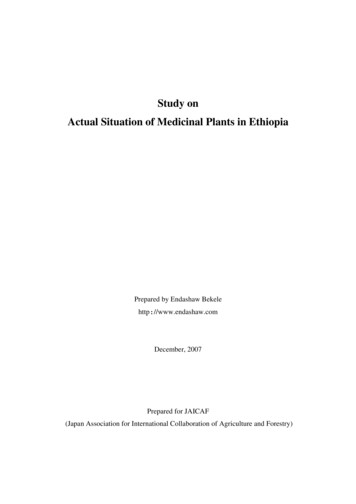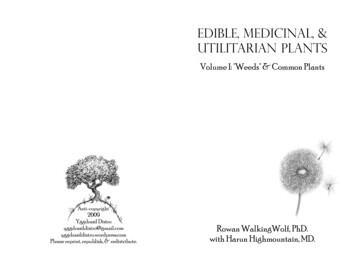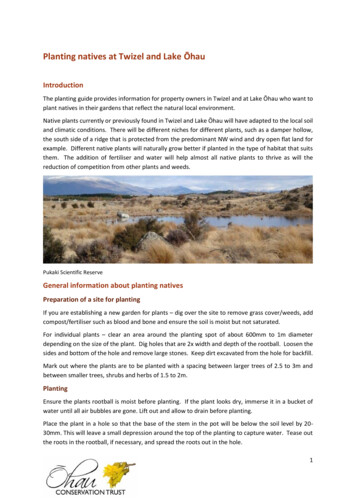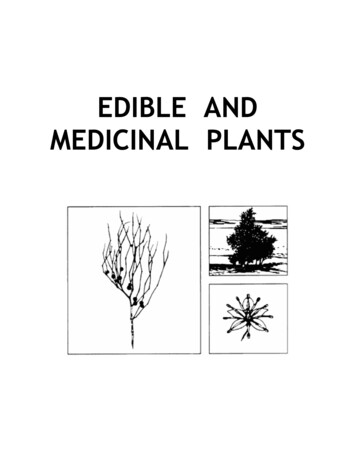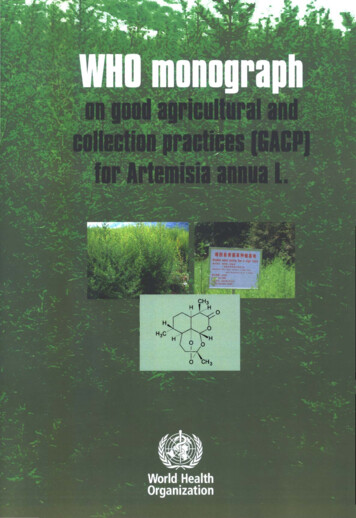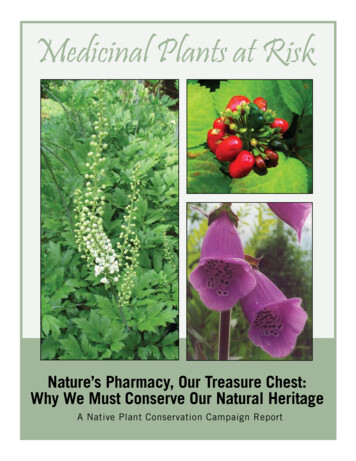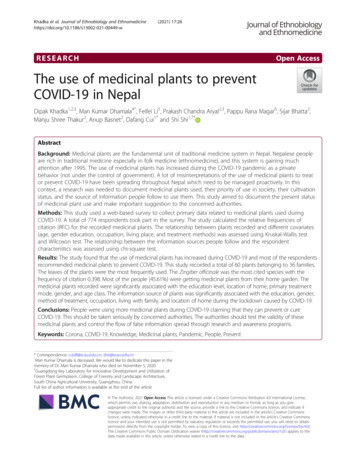
Transcription
Khadka et al. Journal of Ethnobiology and 449-w(2021) 17:26RESEARCHOpen AccessThe use of medicinal plants to preventCOVID-19 in NepalDipak Khadka1,2,3, Man Kumar Dhamala4ˆ, Feifei Li5, Prakash Chandra Aryal2,3, Pappu Rana Magar6, Sijar Bhatta2,Manju Shree Thakur2, Anup Basnet2, Dafang Cui1* and Shi Shi1,7*AbstractBackground: Medicinal plants are the fundamental unit of traditional medicine system in Nepal. Nepalese peopleare rich in traditional medicine especially in folk medicine (ethnomedicine), and this system is gaining muchattention after 1995. The use of medicinal plants has increased during the COVID-19 pandemic as a privatebehavior (not under the control of government). A lot of misinterpretations of the use of medicinal plants to treator prevent COVID-19 have been spreading throughout Nepal which need to be managed proactively. In thiscontext, a research was needed to document medicinal plants used, their priority of use in society, their cultivationstatus, and the source of information people follow to use them. This study aimed to document the present statusof medicinal plant use and make important suggestion to the concerned authorities.Methods: This study used a web-based survey to collect primary data related to medicinal plants used duringCOVID-19. A total of 774 respondents took part in the survey. The study calculated the relative frequencies ofcitation (RFC) for the recorded medicinal plants. The relationship between plants recorded and different covariates(age, gender education, occupation, living place, and treatment methods) was assessed using Kruskal-Wallis testand Wilcoxon test. The relationship between the information sources people follow and the respondentcharacteristics was assessed using chi-square test.Results: The study found that the use of medicinal plants has increased during COVID-19 and most of the respondentsrecommended medicinal plants to prevent COVID-19. This study recorded a total of 60 plants belonging to 36 families.The leaves of the plants were the most frequently used. The Zingiber officinale was the most cited species with thefrequency of citation 0.398. Most of the people (45.61%) were getting medicinal plants from their home garden. Themedicinal plants recorded were significantly associated with the education level, location of home, primary treatmentmode, gender, and age class. The information source of plants was significantly associated with the education, gender,method of treatment, occupation, living with family, and location of home during the lockdown caused by COVID-19.Conclusions: People were using more medicinal plants during COVID-19 claiming that they can prevent or cureCOVID-19. This should be taken seriously by concerned authorities. The authorities should test the validity of thesemedicinal plants and control the flow of false information spread through research and awareness programs.Keywords: Corona, COVID-19, Knowledge, Medicinal plants, Pandemic, People, Prevent* Correspondence: cuidf@scau.edu.cn; shis@scau.edu.cnˆMan Kumar Dhamala is deceased. We would like to dedicate this paper in thememory of Dr. Man Kumar Dhamala who died on November 5, 2020.1Guangdong Key Laboratory for Innovative Development and Utilization ofForest Plant Germplasm, College of Forestry and Landscape Architecture,South China Agricultural University, Guangzhou, ChinaFull list of author information is available at the end of the article The Author(s). 2021 Open Access This article is licensed under a Creative Commons Attribution 4.0 International License,which permits use, sharing, adaptation, distribution and reproduction in any medium or format, as long as you giveappropriate credit to the original author(s) and the source, provide a link to the Creative Commons licence, and indicate ifchanges were made. The images or other third party material in this article are included in the article's Creative Commonslicence, unless indicated otherwise in a credit line to the material. If material is not included in the article's Creative Commonslicence and your intended use is not permitted by statutory regulation or exceeds the permitted use, you will need to obtainpermission directly from the copyright holder. To view a copy of this licence, visit http://creativecommons.org/licenses/by/4.0/.The Creative Commons Public Domain Dedication waiver ) applies to thedata made available in this article, unless otherwise stated in a credit line to the data.
Khadka et al. Journal of Ethnobiology and Ethnomedicine(2021) 17:26BackgroundThe new coronavirus disease (COVID-19) pandemic hascaused global socioeconomic disturbances with a worrisome number of deaths and health issues, and the worldhas been struggling to find medicine to treat and preventCOVID-19 [1]. A number of combinations and trialshave been done, but so far, they have not producedpromising results [2–4]. The different types of misinformation related to COVID-19 have been spreadingthroughout the world through social media [5], including use of medicinal plant products to prevent or cureCOVID-19. Due to this situation, ethnobiologists shouldcollaborate with local people and document the medicinal plants used with caution to stop the inaccuratesharing of information [6].There is a strong inter-relationship between people andplants according to needs [7–10]. People are dependenton plants for different purposes such as for food, medicine, and houses [11–13]. Plant species have always been afundamental source for the discovery of drugs [14]. Peoplehad used medicinal plants to fight against pandemics inthe past [15–17], and dependency of people on medicinalplants might have increased in these days around theworld as medicinal plants can be an alternative option toprevent COVID-19 [18].Different researchers have suggested herbal medicine as apotential option to cure or prevent COVID-19 [19, 20].Countries like China and India are integrating their usewith western medicine to boost the immunity power ofCOVID-19 patients [21, 22]. In China, traditional medicineshowed encouraging results in improving symptom management and reducing the deterioration, mortality, and recurrence rates [23]. On the other hand, the World HealthOrganization (WHO) (2020) claims medicinal plants mightbe good for the health and in supporting the immune system, but not in preventing or curing COVID-19. TheWHO Africa (2020) claims unscientific products to treatCOVID-19 can be unsafe for people, as they may abandonself-hygienic practices, may increase self-medication, andmay be a risk to patient safety.Lifestyle, diet, age, sex, medicinal conditions, and environmental factors have been playing an important rolein the personal fate towards the severity of COVID-19[24]. The source of information, such as social media,plays an important role to combat pandemics [25, 26].People receive information regarding COVID-19 andother diseases from different sources including the socialmedia, local people, national health authorities, and theWHO, based on respondent characteristics such as ageand gender as well as occupation, state of their living,and primary mode of disease treatment method [27].In Nepal, the medicinal plants are often used in thetraditional medicine system, which includes Scholarlymedical system (The Ayurveda, homeopathy, the Unani,Page 2 of 17and the Tibetan medicine), Folk medicine (ethnomedicine, community medicine, household medicine, and anyother forms of local medicines), and Shamanistic(Dhami-jhankri, Jharphuke, Pundit-Lama-Pujari-Gurau,and Jyotish). Among them, folk medicine system is usingmore medicinal plants in Nepal [28]. The first scientificresearch published in ethnobotany is dated back to 1955[29]. More than 80% of the people in Nepal have beenusing traditional medicine such as medicinal plants [30,31]. Medicinal plants are the primary source of healthcare for the people in Nepal and are an integral part oftheir culture [32, 33]. Most of the people i
(age, gender education, occupation, living place, and treatment methods) was assessed using Kruskal-Wallis test and Wilcoxon test. The relationship between the information sources people follow and the respondent . using Microsoft Excel 2013. The medicinal plants recorded were tabulated in the table with respective scientific, local, and .


